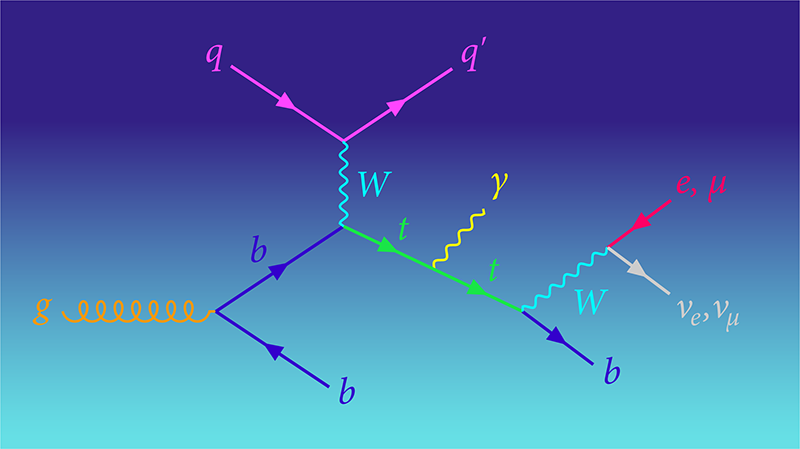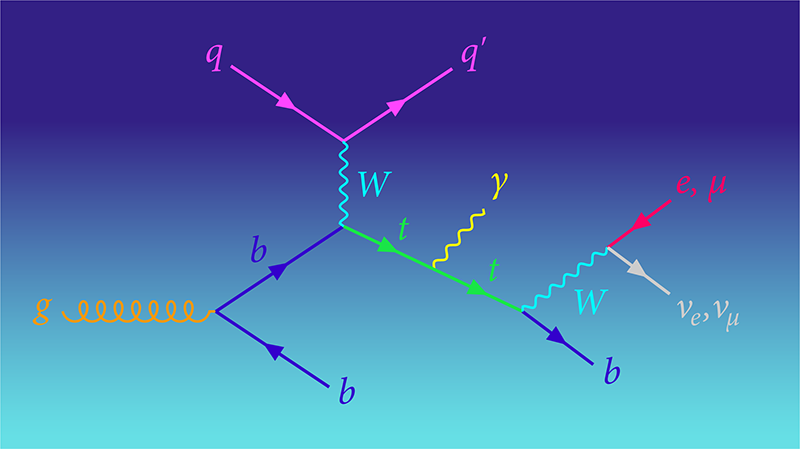Observation of a Single Top Quark and a Photon
In the ever-evolving landscape of particle physics, a field that explores the nature of the Universe’s fundamental building blocks, nothing generates a buzz quite like a world’s first. Such a first is exactly what CERN’s ATLAS Collaboration has now achieved with its observation of the coincident production of single top quarks and photons in proton–proton collisions at the Large Hadron Collider (LHC) [1] (Fig. 1). This discovery provides a unique window into the intricate nature of the so-called electroweak interaction of the top quark, the heaviest known fundamental particle.
The standard model of particle physics defines the laws governing the behavior of elementary particles. Developed 50 years ago [2, 3], the model has—to date—withstood all experimental tests of its predictions. But the model isn’t perfect. One of the model’s biggest problems is a theoretical one and relates to how the Higgs boson gives mass to other fundamental particles. The mechanism by which the Higgs provides this mass is known as electroweak symmetry breaking, and while the standard model gives a reasonable description of the mechanism, exactly how electroweak symmetry breaking comes about remains a mystery.
This mystery is behind the intense scrutiny of the Higgs boson that is currently at the forefront of LHC’s scientific program [4, 5]. To better understand the Higgs, researchers also started investigating its closest associates—the particles with which it most strongly interacts. These particles, which include the top quark and the force carriers of the electroweak interaction (the W and Z bosons), are the most massive in the standard model. By accurately measuring the properties of these particles in collision-induced processes, such as the associated production of a top quark and a photon ( ), and then comparing those measurements to standard-model predictions, we hope that we will find small deviations in particle behaviors. These deviations could provide hints of new particles that would help solve the Higgs-mass mystery. But these collision-induced processes tend to be relatively rare.
Previously, a single top quark had only been seen in association with a W or a Z boson—the photon was absent despite its higher probability of occurring. The production processes behind single-top-quark events are highly sensitive to top-quark electroweak interactions [6–8]. But they are much harder to observe than production processes that create particle pairs, for example, a top–antitop quark pair. That difficulty comes because single-top-quark events are significantly rarer than pair ones and because the presence of similar looking top–antitop quark-pair events can swamp single-top-quark signals.
The measurement achieved by the ATLAS Collaboration targeted the so-called leptonic decay of the W boson after a event. After its production, the top quark immediately decays into a W boson and a bottom (b) quark. The W boson then decays into either a pair of quarks or a charged lepton (electron or muon) and a neutrino. Identifying and measuring the properties of charged leptons is significantly easier than doing the same for the quarks, which join in pairs to create hadrons, so lepton channels are always the first port of call for measuring top-quark processes.
For its observation, the ATLAS team analyzed only the subset of events that contained all the final-state particles expected to be produced in : a photon, a “b jet” (a cluster of energetic hadrons deemed likely to have originated from a b quark), a lepton, and some missing energy, the hallmark of a neutrino, which does not leave a trace in the detectors. The researchers were able to select out these events using machine-learning algorithms trained on simulated data. The machine-learning algorithm outputs were also used to extract the experimental rate, along with its uncertainty. The team determined the observation had a significance of 9.8 , a value that makes the probability that this observation was due to a random data fluctuation practically zero.
Intriguingly, the experimentally determined rate of 688 femtobarn is about 30%–40% higher than the 515 femtobarn predicted by the standard model. The quoted uncertainty in the measured rate is about 10%, suggesting tension between the data and the model. (The statistical confidence of the tension was 2 sigma.) A previous analysis made by CERN’s CMS Collaboration also suggested that the rate might be higher than predicted [9].
In the global context of top-quark physics, this measurement can be viewed as a key one in the search for new particles. Using hundreds of past LHC measurements, researchers have performed several large-scale statistical analyses to search for unpredicted interactions between standard-model particles that would point to the existence of new particles [10–14]. These studies have highlighted the relatively poor understanding of top-quark electroweak interactions, one of the motivating factors behind making this new observation. I am personally very much looking forward to seeing how these data impact our understanding of the top quark and its interactions with other key players in the electroweak symmetry-breaking mystery.
My hope is that this observation is just the tip of the iceberg: as more data are collected, analysts should be able to glean properties of events beyond the total rate, which should make it easier to spot possible new interactions. I doubt we will have to wait long for these data nor for the analyses that will follow the data’s arrival. But for now, it remains an open question as to whether this measurement indeed indicates physics beyond the standard model.
References
- G. Aad et al. (ATLAS Collaboration), “Observation of single-top-quark production in association with a photon using the ATLAS detector,” Phys. Rev. Lett. 131, 181901 (2023).
- S. Weinberg, “A Model of Leptons,” Phys. Rev. Lett. 19, 1264 (1967).
- A. Salam, “Weak and electromagnetic interactions,” in Elementary Particle Physics, edited by N. Svartholm (Almqvist and Wiksell, Stockholm, 1968), p. 367.
- (ATLAS Collaboration), “Observation of a new particle in the search for the Standard Model Higgs boson with the ATLAS detector at the LHC,” Phys. Lett. B 716, 1 (2012).
- (CMS Collaboration), “Observation of a new boson at a mass of 125 GeV with the CMS experiment at the LHC,” Phys. Lett. B 716, 30 (2012).
- M. Farina et al., “Lifting degeneracies in Higgs couplings using single top production in association with a Higgs boson,” J. High Energ. Phys. 5 (2013).
- C. Degrande et al., “Single-top associated production with a Z or H boson at the LHC: the SMEFT interpretation,” J. High Energ. Phys. 10 (2018).
- F. Maltoni et al., “Top-quark electroweak interactions at high energy,” J. High Energ. Phys. 10 (2019).
- A. M. Sirunyan et al. (CMS Collaboration), “Evidence for the associated production of a single top quark and a photon in proton-proton collisions at ,” Phys. Rev. Lett. 121, 221802 (2018).
- A. Buckley et al. (TopFitter Collaboration), “Constraining top quark effective theory in the LHC Run II era,” J. High Energ. Phys. 4 (2016).
- I. Brivio et al., “O new physics, where art thou? A global search in the top sector,” J. High Energ. Phys. 2 (2020).
- J. Ellis et al., “Top, Higgs, diboson and electroweak fit to the Standard Model effective field theory,” J. High Energ. Phys. 4 (2021).
- J. Ethier et al. (SMEFiT Collaboration), “Combined SMEFT interpretation of Higgs, diboson, and top quark data from the LHC,” J. High Energ. Phys. 11 (2021).
- V. Miralles et al., “The top quark electro-weak couplings after LHC Run 2,” J. High Energ. Phys. 2 (2022).





